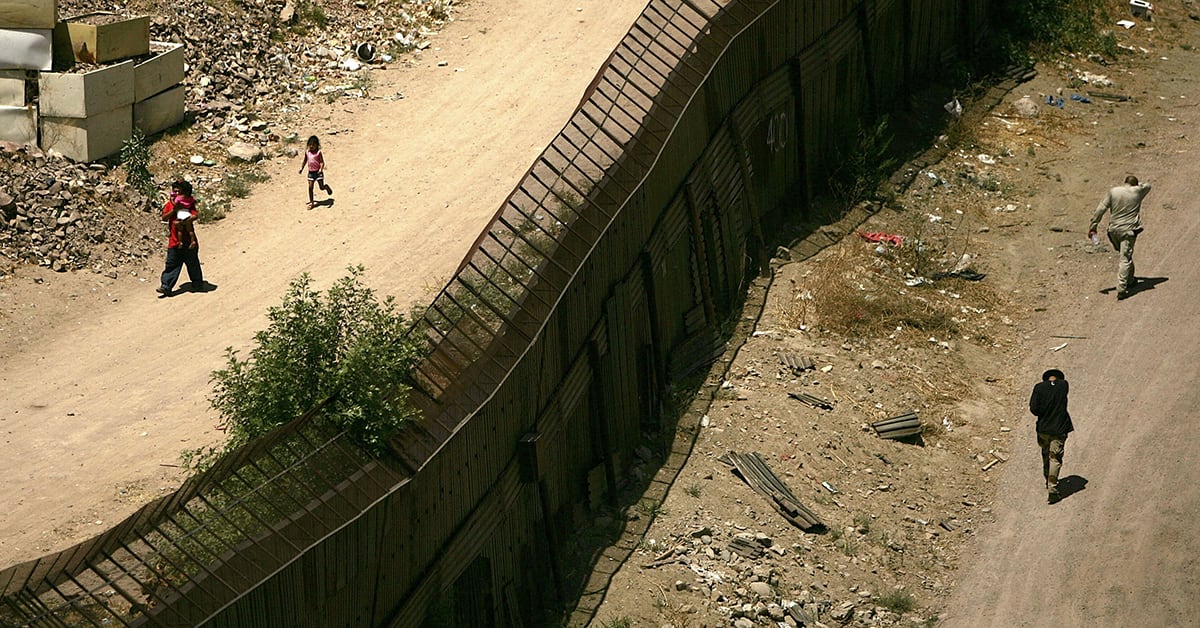UPDATE: This story was originally published in 2006 and has been reposted to provide context to current events.
NOGALES, Ariz. ― When President Bush ordered up to 6,000 National Guard troops to the southwest border, Pfc. Mike Baldwin was quick to volunteer.
In fact, Baldwin, of the 258th Engineer Company in Phoenix volunteered for the entire two-year mission.
“I’m kind of gung-ho. I wanted to help out the country and the Border Patrol,” he said. “I didn’t know how bad [the problem] was until I got in the middle of it.”
As the National Guard juggles an increasingly busy operations tempo at home and abroad, it’s looking for more people like Baldwin to serve alongside U.S. Customs and Border Protection Border Patrol agents.
“It’s not your father’s or grandfather’s National Guard,” said Col. Patrick Tennis, deputy director of operations for the National Guard Bureau. “Our support in Iraq and Afghanistan has not declined. The Balkans [mission is] not going away. We are a very, very busy force.”
Currently, most of the troops supporting the border mission in California, Arizona, New Mexico and Texas are volunteers who signed up for at least 30 days, Tennis said.
Soldiers and airmen on annual training make up the rest of the force. Lt. Gen. H. Steven Blum, chief of the National Guard Bureau, has said 50,000 to 60,000 troops will spend annual training on the border during the first year of the mission, also known as Operation Jump Start.
About half of the border force will man entry identification teams, 25 percent will be engineers, 10 percent will provide aviation support and the rest will do base operations, according to information from Tennis.
The soldiers and airmen will support the Border Patrol while the agency hires and trains 6,000 new agents. The Border Patrol now has about 12,000 agents, 88 percent of whom are stationed on the 2,000-mile southwest border, said Gustavo Soto, a supervisory Border Patrol agent in the Tucson sector.
Agents on the southwest border make 98 percent of all the agency’s apprehensions, Soto said. The presence of National Guard troops has already made a difference for the busy agents.
“The National Guard has proven to be more than what we expected,” Soto said. “Since the Guard first deployed here, we’ve seen incremental drops in entries. We must know who’s coming into the country. We cannot have open borders. There are a lot of economic immigrants, but we have a lot of criminals, too.”
The tricky part of Operation Jump Start is providing the right mix of troops, said Tennis, who anticipates the Guard will finish its work on the border by July 15, 2008. For example, engineers are in high demand to build roads and fences, but they’re also tapped for missions overseas.
“They’re sized for the overseas war fight. We’re utilizing them regularly overseas, [and] this requirement on the southwest border adds additional stress to a force that’s already busy,” Tennis said.
Aviation is another area that could be challenged by the two-year border mission.
Lt. Col. Garrett Jensen, chief of the Army Guard’s aviation operations and training branch, said officials plan to put an aviation task force in each of the four southwest border states.
These task forces will be built around security and support battalions designed for domestic missions that have not been deployed for the global war on terrorism.
The Army Guard has six of these battalions across the country, each with 24 OH-58 Kiowas, and the idea is to put a headquarters element in each state and beef them up with crews that would rotate in and out. Each task force also will have UH-60 Black Hawks and HH-60 medevac Black Hawks, Jensen said.
The four task forces should be in place during the first quarter of fiscal 2007.
Throughout the two-year mission, officials will look across the country for troops who want to serve on the border. As of Aug. 30, governors from 43 states had signed a memorandum of agreement allowing their troops to volunteer, according to Lt. Col. Jeff Pounding, deputy division chief for Army Guard operations.
The Guard also will shift annual training opportunities during fiscal 2007 so that units can serve on the border all year, he said.
“It’s easier if you put guys on annual training status down at the border in the summer months because that’s when they normally do it,” Pounding said. “But if we say November or December, it’s a nice time of the year. How nice of a break would it be if you’re from Minnesota and you get to spend two weeks in Arizona?”
The 258th Engineer Company of Phoenix spent two weeks in August building an all-weather road near downtown Nogales. Their work will help the Border Patrol better navigate the area’s rugged terrain.
“We are coming back to the Arizona border next year [for annual training] and we’ll be here for three weeks,” said Capt. Kathleen Sprinkle, commander of the 258th. And instead of trying to build a road during Arizona’s “monsoon season,” Sprinkle said she’s looking to move annual training to the spring.
“It’s tough being here only two weeks,” said Sgt. 1st Class Anthony Newlin, noncommissioned officer in charge of the 258th’s border project. “What we start, we want to finish. It’s a point of pride, [but] a project of this magnitude is hard to do in two weeks.”
The work done by the troops is invaluable, Soto said.
The Border Patrol estimates it would pay $2.9 million per mile for all-weather roads built in the Tucson sector by a private contractor, compared to $500,000 per mile, the military cost, Soto said. Fencing by a private contractor would cost $4.4 million per mile but $1.1 million per mile by the military.
Troops who spent the summer under Arizona’s blazing sun helping the Border Patrol spot illegal immigrants were surprised by the number of people who attempt to sneak into America every day.
“CNN and all the major media keep reporting that [immigration is] not a big deal and it doesn’t happen in our backyard,” said Capt. Brian Watson, of the 116th Infantry Brigade Combat Team in Staunton, Va. “I got down here and realized it’s a major problem.”
Baldwin has mixed feelings about the people trying to cross. “They’re looking for better jobs and better lifestyles. They risk their lives to come here,” he said. “Any human would feel sorry for them but I’ve been given a mission. I have to keep my feelings neutral.”
Sgt. Frederick Nicholas, of the 54th Brigade in Virginia Beach, Va., is part of an entry identification team in Sasabe, a remote town west of Nogales. Nicholas and his fellow soldiers often see scouts on the other side of the border. These scouts help guide illegal immigrants away from Border Patrol agents.
“We can see them watching us. They’re sitting there all day long with their binoculars,” Nicholas said.
“It’s not just the Mexicans we’re worried about but other people coming through,” he said. “You have the ones trying to get drugs through. You don’t know which ones are which.
“It’s not our job to be the judge and jury. We’re just here to do our job.”
About the U.S. Border Patrol
* The agency has about 12,000 agents nationwide. About 11,000 serve on the southwest border.
* 98 percent of all apprehensions take place along the 2,000-mile southwest border. In fiscal 2005, agents in California, Arizona, New Mexico and Texas apprehended 1.17 million illegals.
* In fiscal 2005, agents nationwide seized more than 12,300 pounds of cocaine and more than 1.2 million pounds of marijuana. The drugs were worth an estimated $1.4 billion.
* The Tucson sector in Arizona, one of nine sectors along the southwest border, is one of the busiest. It is 262 linear miles, and 2,400 to 2,500 agents are assigned to the area. As of Aug. 30, agents had apprehended more than 368,159 illegal crossers this fiscal year, and seized more than 601,392 pounds of marijuana.
Sources: Gustavo Soto, supervisory Border Patrol agent, and www.cbp.gov.
About the National Guard
* About 340,000 soldiers and 109,000 airmen belong to the National Guard. About 56,000 soldiers are currently mobilized for the global war on terrorism.
* Texas has about 20,200 soldiers and airmen, the most of the four southwest border states. California is assigned 20,000, Arizona has 7,400 and New Mexico has 4,000.
* The Army Guard will be responsible for about 75 percent of the 6,000 troops working along the southwest border. The Air Guard will provide the remaining 25 percent.
Sources: National Guard Bureau
Michelle Tan is the editor of Army Times and Air Force Times. She has covered the military for Military Times since 2005, and has embedded with U.S. troops in Iraq, Afghanistan, Kuwait, Haiti, Gabon and the Horn of Africa.





